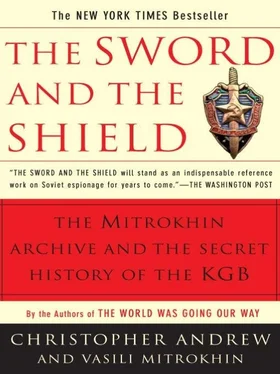THE RUNNING COSTS for the main intercept posts in KGB residencies around the world in 1979 show that the Washington and New York operations were by far the most expensive. 63The SIGINT post in the Havana residency, the third most expensive, was also focused chiefly on the United States. All other intercept posts were also instructed to give priority, when possible, to the communications of the Main Adversary. The most important of the KGB’s foreign intercept posts targeted on the United States from outside, however, was located not in a residency but in the large SIGINT base set up by the GRU at Lourdes in Cuba in the mid-1960s to monitor US navy communications and other high-frequency transmissions. 64On April 25, 1975 a secret Soviet government decree (no. 342—115) authorized the establishment of a new KGB SIGINT station (codenamed TERMIT-P) within the Lourdes base, which began operations in December 1976. Run by the Sixteenth Directorate, TERMIT-P had a fixed 12-meter dish antenna and a mobile 7-meter dish antenna mounted on a covered lorry, which enabled it to intercept microwave communications “downlinked” from US satellites or transmitted between microwave towers. 65Other large GRU/Sixteenth Directorate SIGINT stations established in the late 1970s included those in South Yemen and at Cam Ranh Bay in Vietnam. The biggest, however, remained the Lourdes complex, which continued to grow steadily over the next decade. President Reagan declared in 1983:
The Soviet intelligence collection facility less than 100 miles from our coast is the largest of its kind in the world. The acres and acres of antennae fields and intelligence monitors are targeted on key US military installations and sensitive activities. The installation, in Lourdes, Cuba, is manned by 1,500 Soviet technicians, and the satellite ground station allows instant communication with Moscow. This 28-square-mile facility has grown by more than 60 percent in size during the past decade.
A joint report by the Departments of State and Defense in 1985 estimated that the total personnel at the Lourdes SIGINT base had increased further to 2,100. 66
By the early 1980s all KGB residencies possessed an intercept post. 67Each post was required to submit an annual report to the Centre in November, giving details of encrypted and plain text material intercepted over the past year; the proportion of operationally significant intercepts; newly discovered communications channels of intelligence value; characteristics of the “radio-intelligence environment” in the country concerned; the handling and fulfillment by the intercept post of its SIGINT assignments; measures taken to protect the security and secrecy of its operations; conclusions about past performance and proposals for the future. 68
In 1980 the Washington area POCHIN posts reported that, as a result of new security precautions, it had become much more difficult to intercept the communications of the federal government. 69The residency there, however, reported one major new SIGINT success. In September 1980, after two years’ planning, in an operation codenamed FLAMINGO, the residency succeeded in bugging the conference room of System Planning Corporation (SPC), a private company in Arlington, Virginia, which did research for the Pentagon. Viktor Vasilyevich Lozenko (code-named MARVIN), a Line X (scientific and technological intelligence) officer under diplomatic cover at the Washington residency, had noticed that the SPC conference room was also used for meetings of the Society for Operational Research, of which he was a member. The day before he left Washington at the end of his tour of duty, he succeeded in fixing the listening device—a battery-powered rod a quarter of a meter long—underneath a table in the room. The signal from the bug was monitored from a command post in a car with diplomatic number plates, fitted with a T-shaped antenna built into the front windshield, which took up position at one of nine locations situated at distances of 300-500 meters from the SPC offices.
For the next ten and a half months operation FLAMINGO provided what the Centre considered “highly important” intelligence on the current and future deployment of US nuclear weapons in Europe, on American chemical weapons, on the US navy’s chances of survival in a nuclear conflict, and on the US position on the SALT-2 talks. On January 27, 1981 a senior Pentagon official presented a classified report at a meeting entitled “Current Status and Trends in the Advancement of the US Nuclear Forces in the Central European Theater of War.” Among the issues discussed at the meeting were: American mobilization capabilities; the effectiveness of laser guidance systems; plans for the destruction of 730 tons of chemical weapons which were now unusable; and the extent of US intelligence on, and requirements concerning, Soviet chemical weapons. Other meetings in the bugged conference room, also attended by senior Pentagon officials, discussed the current status and proposed reforms of the US armed forces. The operation came to an end not because the listening device was discovered but because its power supply gradually ran out. 70
Four of the KGB officers involved in operation FLAMINGO received the Order of the Red Star: Lozenko, who selected the location and placed the bug; V. I. Shokin, who supervised the operation; the head of the POCHIN station Yuri Nikolayevich Marakhovsky, who played a leading role in collecting and processing the intelligence collected from the SPC conference room; and Yuri Vasilyevich Gratsiansky, head of the residency’s Operational—Technical Support section, who was responsible for the technical side of the operation. Three other residency officers received lesser awards. 71
SOVIET SIGINT OPERATIONS, like those of the United States, were assisted by allied agencies. The UKUSA Security Agreement concluded in 1948 between the United States, the United Kingdom, Canada, Australia and New Zealand provided for the division of collection tasks and the sharing of the product between their SIGINT services. 72The KGB, however, was determined to give its allies only limited access to its cryptanalytic secrets. In January 1975 Andropov approved “Regulations on the Principles and Directions of Co-operation with the Security Agencies of the Socialist Countries in Decryption Operations,” drafted by the Sixteenth Directorate. Its two guiding principles were, first, that joint operations with the “friends” (allied agencies) were to be under KGB control; second, that cryptographic information supplied to allied agencies “should not disclose the level of the latest [Soviet] achievements in the field of cryptanalysis:”
Bearing in mind that at the present time the related services of our friends have acquired a certain experience of working on and exploiting [SIGINT] targets by the methods of electronic [computer-based] cryptanalysis, there is some possibility that in future our friends may try to apply these methods independently against other targets as well. In these conditions, it is essential to strengthen further the co-operation between the Sixteenth Directorate and the related services of our friends with a view to exclude uncontrolled operations which could cause irreparable harm to the Sixteenth Directorate with regard to the application of the methods of electronic cryptanalysis.
On no account were the “friends” to learn of the existence of the top secret training school for KGB cryptanalysts; they were to be given the impression that all training took place at the Centre. Though, on occasion, allied agencies could be given cipher communications from shortwave transmissions intercepted by the Sixteenth Directorate, they were never allowed access to SIGINT from residency intercept posts, satellite communications or telegraph lines within the Soviet Union. 73
Despite the Sixteenth Directorate’s reluctance to share most SIGINT secrets with its intelligence allies, it depended on their assistance. With the growing complexity of computer-generated cipher systems, Soviet cryptanalysts were increasingly dependent on the penetration of foreign embassies to steal cipher materials and, when possible, bug cipher machines and teleprinters. During 1974 alone joint operations by the FCD Sixteenth Department and its Soviet Bloc allies succeeded in abstracting cipher material from at least seven embassies in Prague, five in Sofia, two in Budapest and two in Warsaw. 74Soviet Bloc intelligence services also shared some of their agents in Western embassies and foreign ministries with the KGB. Among those who were particularly highly rated by the KGB Sixteenth Directorate was a Bulgarian agent codenamed EPIR, a security official in the Greek foreign ministry recruited by Bulgarian intelligence in 1966. Over the next ten years he assisted in the removal of over 12,000 classified pages of documents from the ministry. 75
Читать дальше











